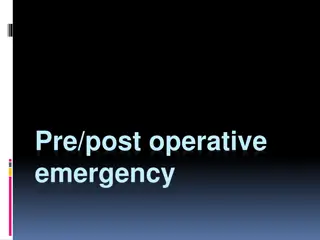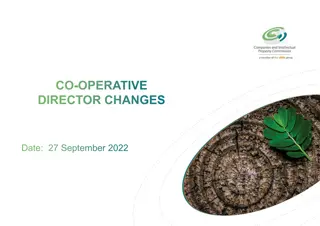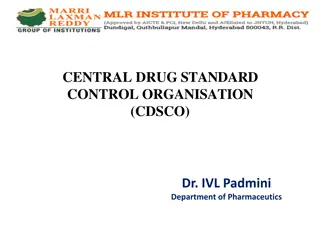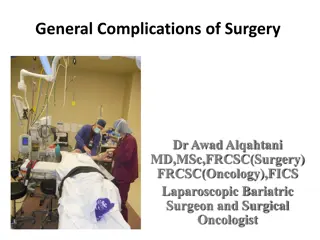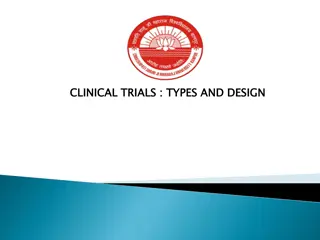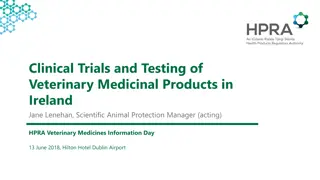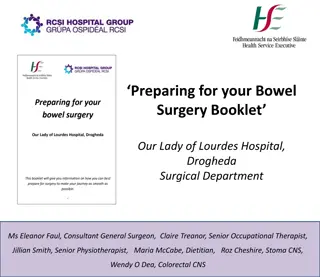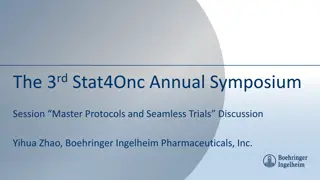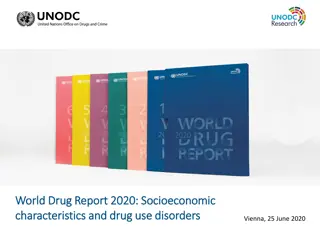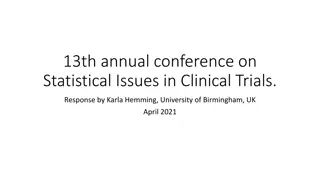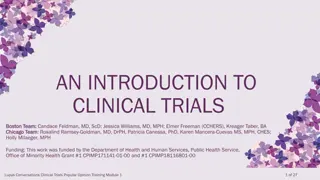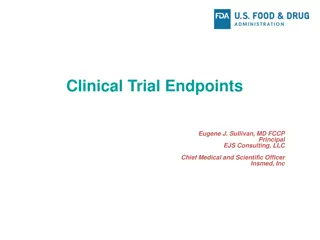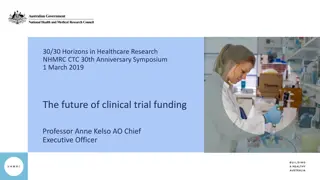Pre-Operative Clinical Trials In Drug Development
This content delves into the role of pre-operative trials in cancer drug development, key trial elements, and the design of a pre-operative platform trial. It discusses different types of clinical trials in the perioperative setting and the paradigms of drug development in oncology. Overall, it highlights the unique opportunity the pre-operative setting provides for accelerating drug and biomarker development.
Download Presentation

Please find below an Image/Link to download the presentation.
The content on the website is provided AS IS for your information and personal use only. It may not be sold, licensed, or shared on other websites without obtaining consent from the author.If you encounter any issues during the download, it is possible that the publisher has removed the file from their server.
You are allowed to download the files provided on this website for personal or commercial use, subject to the condition that they are used lawfully. All files are the property of their respective owners.
The content on the website is provided AS IS for your information and personal use only. It may not be sold, licensed, or shared on other websites without obtaining consent from the author.
E N D
Presentation Transcript
Pre-Operative Clinical Trials In Drug Development Tricia Cottrell MD, PhD Wendy Parulekar MD, FRCP(C)
Workshop Objectives To identify role(s) of pre-operative trials in cancer drug development Identify key trial elements that guide the design of pre-operative trials Design a pre-operative platform trial testing novel agents in patients with resectable NSCLC 2
Clinical Trials in the Perioperative Setting Preoperative Neoadjuvant: Therapeutic intent trials that test novel treatment; use an intermediate endpoint measured at surgery e.g. pathologic complete response measured to surgery Window of Opportunity: Non therapeutic trials that test novel therapies; use a feasibility or biomarker endpoint measured at surgery Ki-67 status Post operative clinical trials Adjuvant: Therapeutic intent trials that test novel treatment strategies; use surgical findings to assign treatments (e.g. presence of residual disease); clinically validated endpoints e.g. event free survival 3
Drug Development In Oncology Paradigm of drug development in the era of cytoxic chemotherapy Direct relationship between toxicity and anti-tumour effect Normal tissue dose limiting toxicity used to select active dose for further testing Paradigm of drug development in the era of targeted therapy May not have direct relationship between toxicity and target inhibition Plateau in target inhibition may occur at lower level than the MTD Greater emphasis on understanding the drug target 4
Drug Development In Oncology Oncology drug development Expensive Time consuming Inefficient high failure rate from drug discovery to regulatory approval The pre-operative setting provides a unique opportunity to accelerate drug and biomarker development by enabling a comprehensive assessment of the pharmacodynamic effects of a novel therapy 5
Pre-Operative Clinical Trials in Drug Development Pros Optimizes the intersection of research and practice workflows In vivo assessment of drug activity Biomarker discovery/validation Surrogate endpoint identification/validation Operative findings to guide adjuvant therapy decisions 6
Pre-Operative Clinical Trials in Drug Development Cons Enhanced multidisciplinary collaboration Surgery, oncology, pathology, radiology Complex consenting procedure non therapeutic intent pre-operative trials Safety considerations e.g. delays in surgery or surgical complication Next steps How do the results impact continued drug development? 7
General Classification of Pre-Operative Clinical Trials Therapeutic Non-Therapeutic Neoadjuvant Administration of multiple cycles of therapy Novel therapy + standard of care Intermediate endpoint e.g. pCR Window of Opportunity Limited administration of a novel therapy Single agent or combination with standard of care Feasibility and/or molecular endpoint e.g. % compliant; change in biomarker(s) 8
Key Design Elements Objective(s) Estimate drug activity; feasibility; tolerability and safety Patient Population All comers versus molecularly defined Endpoint(s) Measure of anticancer activity; change in molecular target; compliance . e.g. pCR; change in biomarker; percentage compliant Statistical Framework H0, HA, (Type 1 error), (Type II error); comparative measures e.g. hazard ratio (hazard ratio) 9
EXAMPLE 1 10
I-SPY 2: Neoadjuvant and Personalized Adaptive Novel Agents to Treat Breast Cancer (I-SPY) (NCT01042379) 11
I-SPY 2: Neoadjuvant and Personalized Adaptive Novel Agents to Treat Breast Cancer (I-SPY) Primary Objective: Determine whether adding experimental agents to standard neoadjuvant medications increases the probability of pathologic complete response (pCR) over standard neoadjuvant chemotherapy for each biomarker signature established at trial entry Secondary Objectives: Predictive and prognostic indices based on qualification and exploratory markers to predict pCR and residual cancer burden (RCB). Three- and five-year relapse-free survival (RFS) and OS among the treatment arms. Adverse events (AEs), serious adverse events (SAEs), and laboratory abnormalities MRI Volume 12
I-SPY 2: Neoadjuvant and Personalized Adaptive Novel Agents to Treat Breast Cancer (I-SPY) Multiple treatment regimens, matched to biomarker signatures graduated to move to phase III trials based on safety and efficacy including Neratinib Veliparib + carboplatin MK2206 TDM1 + pertuzumab Pertuzumab (+ paclitaxel + trastuzumab) Pembrolizumab (+ paclitaxel + adriamycin + cyclophosphamide) 13
General Classification of Pre-Operative Clinical Trials Therapeutic Non-Therapeutic Neoadjuvant Administration of multiple cycles of therapy Novel therapy + standard of care Intermediate endpoint e.g. pCR Window of Opportunity Limited administration of a novel therapy Single agent or combination with standard of care Feasibility and/or molecular endpoint e.g. % compliant; change in biomarker 14
EXAMPLE 2 15
A FEASIBILITY STUDY OF PRE-OPERATIVE SUNITINIB (SU11248) WITH MULTIPLE PHARMACODYNAMIC ENDPOINTS IN PATIENTS WITH T1c-T3 OPERABLE CARCINOMA OF THE BREAST (MA.29) (NCT00482755) 16
A FEASIBILITY STUDY OF PRE-OPERATIVE SUNITINIB (SU11248) WITH MULTIPLE PHARMACODYNAMIC ENDPOINTS IN PATIENTS WITH T1c-T3 OPERABLE CARCINOMA OF THE BREAST (MA.29) Primary Objective: Feasibility of pre-operative administration of this dose of daily, oral sunitinib. Secondary Objectives: Adverse events Response rate Markers of angiogenesis at pre-treatment, end-of-treatment and post-treatment Host and tumour-specific genes in response and toxicity to sunitinib Banking of tumour and blood samples, at pre- treatment, end-of-treatment and post-treatment for future molecular correlative studies Comparison of tumour vascular parameters pre- and end-of-treatment; cell death and tumour microcirculation pre- and post-treatment. 17
A FEASIBILITY STUDY OF PRE-OPERATIVE SUNITINIB (SU11248) WITH MULTIPLE PHARMACODYNAMIC ENDPOINTS IN PATIENTS WITH T1c-T3 OPERABLE CARCINOMA OF THE BREAST (MA.29) Early drug discontinuation rates H0= 20% Ha=5% Two stage design 19 patients would be entered in the first stage, terminate trial if >3 or more patients discontinue sunitinib prematurely for any reason. In the second stage, 23 more patients would be accrued to a total of 42 patients. The regimen under evaluation would be considered feasible if there are 4 or fewer patients overall who discontinue the drug prematurely. Trial activated 2007 March 12 Closed 2010 March 22 due to external phase III data in advanced breast cancer demonstrating lack of efficacy and increase toxicity of sunitinib in combination with chemotherapy; futility compared to single agent capecitabine 18
General Classification of Pre-Operative Clinical Trials Therapeutic Non-Therapeutic Neoadjuvant Administration of multiple cycles of therapy Novel therapy + standard of care Intermediate endpoint e.g. pCR Window of Opportunity Limited administration of a novel therapy Single agent or combination with standard of care Feasibility and/or molecular endpoint e.g. % compliant; change in biomarker 19



